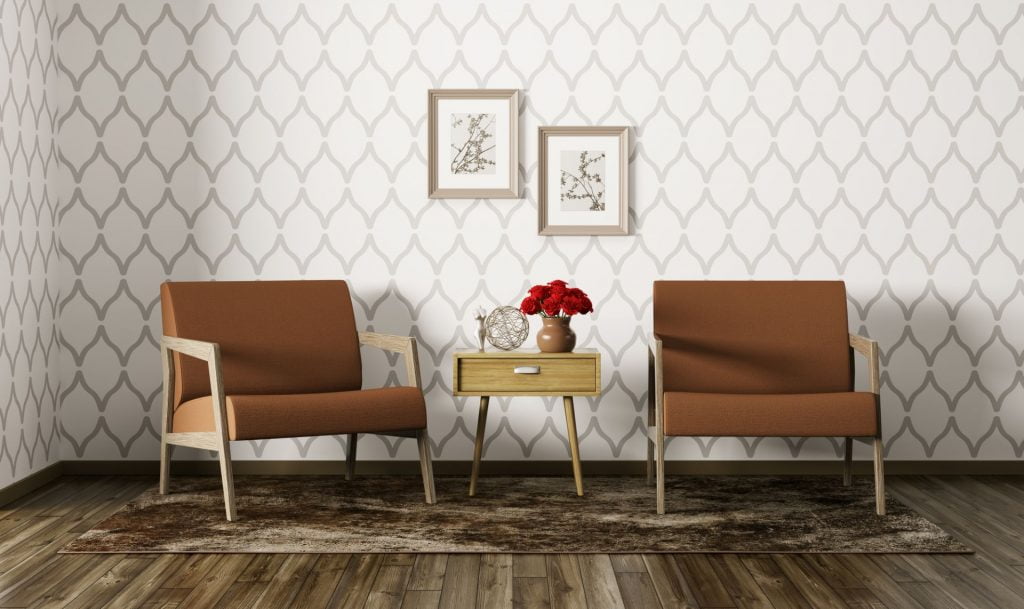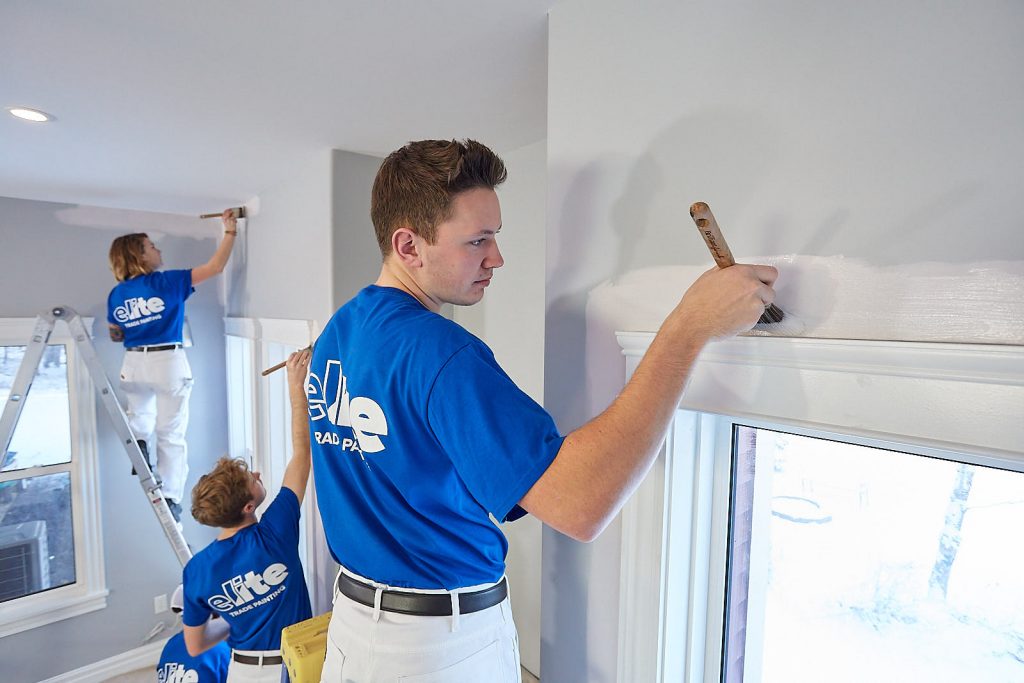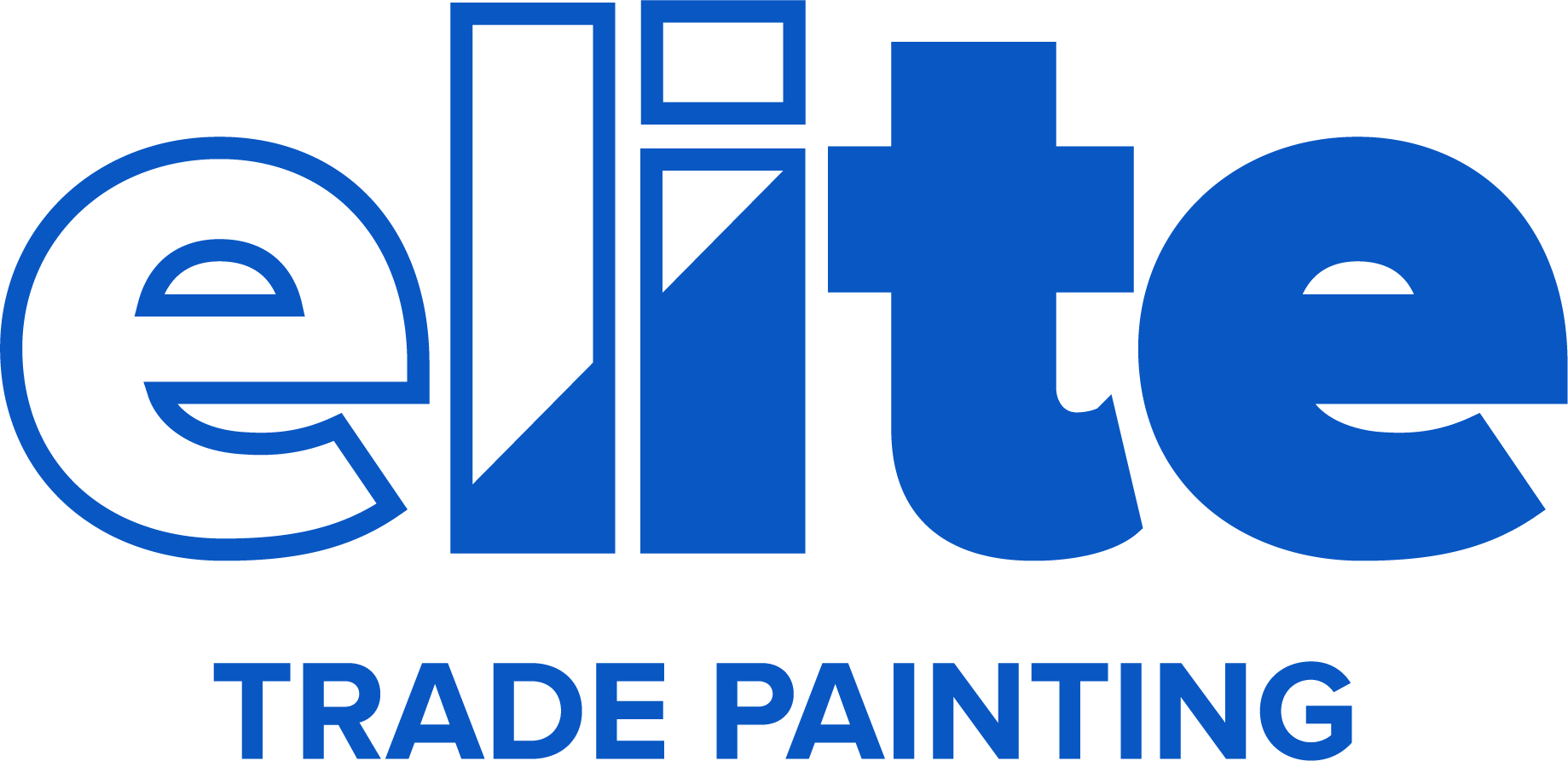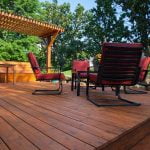Wallpapering and Vinyl Wallcovering vs. Painting Your Walls: Pros and Cons

The time has come to fix up the walls in your home—or perhaps there are just a couple of rooms you’re focused on. You’ve heard that wallpaper and vinyl wall coverings are becoming fashionable again and you find yourself asking, “Should I wallpaper, install vinyl wallcovering or should I paint?”.
The option of vinyl wallcovering is an option that in the past has been used for commercial projects however have made its way into the residential market. Vinyl wallcovering is a great long term option for areas with a wide variety of looks and textures. You choice will come from answering a few other questions that will probably make your decision clearer.
What room or rooms do you intend to renew?
In general, wallpaper and vinyl wall coverings is not the best choice for rooms with high humidity where the temperature is likely to rise and fall, meaning that paint is typically a better choice for kitchens and bathrooms. Since today’s wallpaper and wallcovering materials tends to be durable, it is a good choice for high traffic areas like living rooms, entryways, and hallways. If you do choose to wallpaper in a kitchen or bathroom, you might want to place a tile splash guard a couple of feet above the sink, lavatory, or bathtub.
While choosing between wallpaper, vinyl wallcovering and paint in particular rooms, it’s important to ask whether you want the wall treatment to lighten or darken a room and what tone you want it to set. For instance, if you have an atrium or great room that feels cavernous, darker shades of either paint or wallcovering will keep it from feeling overwhelming. Light shades and brighter colors can make a small room, such as a half-bath, feel larger.
Pros:
- Does well in high traffic areas
- Can use pattern, texture, color to establish an atmosphere in a room
Cons:
- Subject to peeling in humid conditions
- Future removal of wallpaper is costly and time consuming
- Installation costs for wallpaper is high
Pros:
- Great durability, and cleans easily
- Pattern, texture, colour, writeable surfaces and illustrations can used
- Easy removal and conversion to paint
Cons:
- Installation should be done by a professional
- Costs for material is high
- Vinyl wallcovering material can be costly
Pros:
- Preference for rooms with humidity and variable temperatures
- Can set an atmosphere in a room with the choice of color and tone
- Costs are significantly less than wallpaper and vinyl wallcoverings
Cons:
- Shows wear sooner in high traffic areas
Which is more expensive Wallpaper, vinyl wallcovering or Paint ?
There are several important factors involved when considering the cost of wallcovering treatment. First, prices range up with quality. Quality wallpaper prices start at about $10 a roll and range up to $50 per roll which is $.40 to $1.80 per square foot.
Wallpapers
Quality wallpaper prices start at about $10 a roll and range up to $50 per roll which is $.40 to $1.80 per square foot.
Vinyl Wallcoverings
Vinyl wall covering also has a wide range of costs and can be as much as $3.00-5.00 a square foot.
Interior Paint
Interior paint can run less than $20 a gallon and range up to $90 a gallon high equates to as little as $.04 to .20 a square foot.
When considering the price, second, it’s important to know if you are just covering up a dinged, ugly wall that you’re tired of looking at, or are you striving to show some real, lasting elegance? Quality has a way of enduring—and also a way of costing more. So, if you want lasting, attractive wall treatments, you’ll likely be paying around $20+ a roll for wallpaper and about $60 for a gallon of paint.
Another consideration, third, is what sort of finish you want the wallpaper or the paint to show. Wallpaper can be textured and can have amazingly elaborate patterns. Not only is paper like this more expensive, but matching elaborate patterns may mean you waste a bit more paper. Just so with paint, you want to choose the proper sheen or gloss. High gloss paint lasts longer but is primarily used on trim and wooden surfaces. Flat paint is less expensive but easier to deface. You’ll likely want an eggshell or semi-gloss paint for your walls.
Finally, fourth, when it comes to evaluating price, don’t compare apples to oranges. A roll of paper and a gallon of paint may cost about the same. However, a roll of paper at most will cover 28 square feet, while a gallon of paint will cover 200 square feet with two coats.
While discussing expenses, we haven’t talked about the peripheral costs: paintbrushes, paper smoothers, and so forth. If we include these peripheral costs, it implies DIY (you’re doing it yourself). If you use professional installers/painters, you do have to pay them, but the peripheral costs disappear.
Pros:
- An endless variety of patterns available
- Quality paper can cost as little as $10 per roll
Cons:
- An average living room, 480 square feet, can require up to 20 rolls
- A DIY project
Pros:
- Great textures, colours, patterns, writeable surfaces provide a wide choice
- The most durable choice
Cons:
- The most expensive choice
- Not DIY recommended
Pros:
- Can create your own unique custom color
- Bulk paint less expensive than wallpaper and vinyl wall coverings
Cons:
- If DIY, must also account for peripheral painting supplies
How Long Do Wallpaper, vinyl wallcovering and Paint Last?
There’s almost always a little paint left over in a gallon can and we know to set it aside so we can touch up the walls when they get marked or stained. Most quality wallpapers today can be cleaned and even scrubbed as necessary.
To maintain their best appearance, painted walls usually require repainting every three to five years. Even if they are not defaced, they can lose their vibrant sheen and appear dull.
Wallpaper can last up to 15 years, vinyl wallcovering can last even longer. Over time, wallpaper and vinyl wallcovering in brighter rooms may fade, so that replacing a floor-to-ceiling section of paper may make it more obvious than leaving the damaged portion alone. It’s important to remember, also, that simpler patterns age better. That is, the eye doesn’t grow as weary of seeing simple as opposed to complex designs over the years. So, when selecting a wallpaper pattern, it’s good to ask, “Will I enjoy looking at this daily for the next 15 years?”
Pros:
- Longest lasting wall treatment
- Length of wear offsets the initial cost
Cons:
- Wallpaper and vinyl may fade over time
Pros:
- Easier to repair flaws
- Easier to replace
Cons:
- More likely to be defaced with regular wear
Which Is Easier to Apply and to Replace?

There is a great distinction between these two wall treatments when it comes to ease of application and removal, which is not to say that there are no pros and cons for each. These distinctions include the very important question of whether you, as the homeowner, are going to do the work yourself or use professional painters and installers.
When it comes to installing wallpaper and vinyl wallcovering, the first important issue is what is the paper going to cover? If it’s going over a painted wall with no gashes or other needed repair, you can begin by simply painting the wall with a coat of acrylic primer.
This is significant for two reasons: wallpaper will adhere very well to the acrylic and this layer will help to prevent the potential growth of mold. If you’re installing wallpaper over brand new construction and are looking at drywall, it would be painted with a layer of alkyd primer—an important mold inhibitor for such a porous substance as drywall—and then a layer of acrylic. If there is already a layer of wallpaper, it needs to come off. The best way to do this is by using a wallpaper solvent or steamer. Once this is accomplished, fill in any gouges and make sure to sand the wall smooth; then add your acrylic coat.
Applying wallpapers has become easier over time with the advent of new forms of paper as well as new bonding materials. There are several methods for applying paper, but they boil down to prepasted or unpasted paper. With prepasted paper, you expose the paper to water and apply it to the wall. With unpasted paper, you mix and apply the adhesive with a brush, then fit the paper to the wall.
There are a couple of principles here that are important to note.
First, when cutting your paper to fit perfectly on the wall, it’s good to follow the old carpenter’s rubric: measure twice, cut once.
Second, no matter how perfectly you’ve calculated the number of rolls you’ll need to paper a particular wall or room, buy an extra roll.
Vinyl wallcovering installation should be left to the professionals.
Though we’ve already discussed removing wallpaper, it’s worth noting again that old wallpaper should be removed before new paper is installed in its place. Removing old paper may result in creating some small dings in the underlying wall. Spackling and sanding are almost always required before you can begin installing new wallpaper. This can be time consuming and can be very costly. A future change of heart can be expensive. Vinyl wallcovering is much simpler to remove and prepare for paint or new wallcovering.
Applying paint is an entirely different story.

First, assess what is on the surface of the wall you’re about to paint. If this new construction and it’s drywall you’re painting, begin by vacuuming or dusting the wall with a microfiber rag. Your first coat should be a drywall alkyd primer, followed by a primer coat and then a finish coat. Typically, interior latex paint is used for the finish coat.
If the wall has already been painted and any rough spots have been spackled, sanded, and dried, the next thing to determine is what kind of paint you’re covering. In general, latex is almost invariably used on walls in newer houses. If for some reason, oil-based paint was used on the walls, you can prime them with an oil-to-latex product and paint over them with latex.
If your house was built before 1978, you need to determine whether or not lead-based paint was used on the walls you’re painting. If lead-based paint was used and the walls are chipped or the paint is peeling, your best course of action is to hire painting professionals to remove the paint, which otherwise presents the danger of lead poisoning. If the wall is in good shape, you can encapsulate the lead paint by covering it with a coat of a polymer-based encapsulant, which is rolled or brushed on just like another primer coat.
In most cases, replacing the existing paint that’s on a wall is a matter of painting over it. You’ll want to make certain that gouges and rough spots have been filled and sanded. If spackling is required to fill holes, it generally takes 24 hours to the fills to be completely dry. To get smooth, consistent coverage of the wall, it’s best to use a primer coat. When a primer is used, often only a single coat of finish paint is needed.
Pros:
- Today’s wallpapers have measurements on the back to make sizing and keeping straight easier
- Repeats (the center points of a pattern) are clear to help matching pieces of paper
- Prepasted wallpaper removes the need to mix paste and brush on adhesive
Cons:
- Difficult for DIY to master
- Must prime wall before applying paper
Pros:
- 54 inch wide sheets cover areas with minimal seams showing
- Properly prepared walls make the job easier
Cons:
- Install requires knowledge and skill to do properly
- High cost of material makes mistakes costly
Pros:
- Unlimited variety of colors; can create your own unique tone and texture
- Simple, relatively quick application
- New coats and new colors can be added just by painting over
Cons:
- Must apply a paint that adheres to the current surface
- Requires at least two coats for best appearance
Do All Commercial Painters Install Wallpaper and Vinyl Wallcoverings?
Wallpapering, Vinyl wall coverings and interior house painting have become specialized enough that many painters, vinyl installers and paperhangers do not cross into each other’s territory. Therefore, it’s always a good practice to ask professionals who do wall treatments to specify whether or not they both paint, vinyl wall coverings and wallpaper
Perhaps a more significant question to answer before beginning a renovation project involving wallpapering, vinyl wall coverings or painting is whether or not to involve professionals. Again, in order to resolve this issue, there are other questions that, when answered, will help you clarify whether or not seeking commercial installers and painters is in order.
The first question is, are you seeking a casual refresher for the rooms in question or are you after a lasting, elegant update to your home?
When it comes to wallpapering a room, few DIY enthusiasts can hang patterned paper straight enough and match the pieces exactly enough to give it that seamless, professional look. If you hung wallpaper and notice a matching error or a gap in the overlap, it will be the first thing that comes to your mind every time you bring a guest into the room. Commercial paper hangers are also well-versed in removing old wallpaper, smoothing walls, and knowing the right amount of paste or water needed to fix the new paper permanently, correctly to the wall.
Vinyl wallcovering is generally left to the professional. The cost of material and the importance of proper installation to achieve the look desired warrants a high skill level. DIYers can attempt the install but it can be a costly learning curve.
Just so, professional indoor painters are well-acquainted with the types of caulk, primers, and paints that are now in use or which have been used in the past. As such, they’re quick to spot potential safety issues—such a lead paint—and know precisely how to deal with these problems.
Professional painters are also adept at safely covering or moving items so that the paint stays on the walls and trims and not on the floor or furnishings. They are prompt enough to complete a job and have their supplies and tools removed before most DIY folks are halfway through. You do have to pay them, but in saved time and stress and sheer beauty of the result, professional painters pay for themselves.
Pros:
- Professional paperhangers and vinyl installers provide a much quicker, more accurate job than most homeowners can
- Professionals provide all the supplies and are responsible for cleanup
- Professionals have guarantees and warranties that can cover failures
Cons:
- A commercial company will charge up to $10 a square foot to hang wallpaper and more for vinyl installation
Pros:
- Professional painters have the expertise to know what type of paints and primers are needed
- Painters understand how to complete a job quickly and safely
- Painters furnisher all tools and clean up when the job is finished
Cons:
- Painters typically charge from $3 to $6 per square foot of floor space or $.80 to $1per square foot of wall space (varies by region) this does not include trim
 (877) 663-5483
(877) 663-5483 (844) 333-1387
(844) 333-1387



